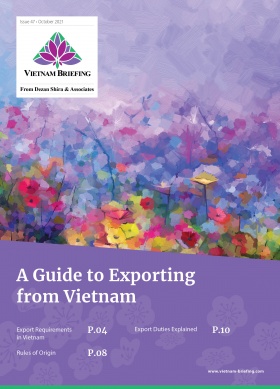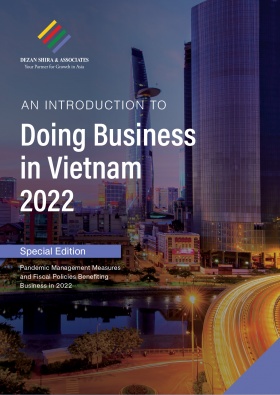Q&A: Doing Business in Vietnam – Looking ahead to 2022
Vietnam persevered through a difficult 2021 as the fourth wave of the pandemic took a significant toll on its economy and people. Nevertheless, despite pandemic measures, lockdowns, and travel restrictions, Vietnam welcomed more than US$19.74 billion of foreign investment in the period ending on December 20, 2021, while adding the RCEP, the CPTPP, and more to its FTA list.
With a solid vision for the future, Vietnam has created a concrete foundation to bounce back stronger in 2022. The government targets GDP growth of 6-6.5 percent, while the World Bank has forecast Vietnam’s GDP to rebound to 5.5 percent provided the pandemic is brought under control both at home and abroad. Among other measures, the government has amended a variety of important laws, which will help improve its business climate.
Recently, Filippo Bortoletti, Vietnam Country Director at Dezan Shira & Associates provided an overview of the key development in the Vietnamese FDI environment as well as emerging opportunities for businesses in Vietnam in 2022 in a webinar. We have shared a few highlights below, however, the full webinar can be viewed here.
Can you describe Vietnam’s business environment recently?
Since the end of the social distancing period at the end of September 2021, Vietnam has been slowly reopening its economy. In line with this, the government launched a pilot project tiered into three steps to completely open the country to international tourism by the second half of 2022, when it is expected that Vietnam will reopen its borders completely after almost two years of restrictions.
This will surely generate significant opportunities in the fields that were heavily impacted by the COVID-19 pandemic, such as tourism, accommodation, and transportation. Meanwhile, Vietnam has trimmed restrictions imposed on the entry of business travelers: now, any business traveler possessing a valid work visa or residency is allowed to enter the country without obtaining several approvals at the local ministries’ departments, saving in terms of costs and – especially – time.
Such improvements were possible thanks to Vietnam’s extremely effective vaccination campaign, which started slowly compared to western countries but ramped quickly with over 70 percent of the population fully vaccinated. Therefore, the outlook for 2022 is very positive.
In the last three years, the economy has remained steady. The top five sectors receiving investment were dominated by manufacturing and processing, followed by electricity production and real estate. In general, the economy grew by 2.58 percent, which was lower than what was forecast but expected due to the effects of the fourth wave of the pandemic and stringent lockdowns. Economic growth, however, was driven by exports which contributed 19 percent to the economy.
Vietnam’s main advantage is the integration of the country in international commerce. Vietnam covers most economic areas and therefore businesses can exploit Vietnam’s integration with other countries through various free trade agreements. There are several other reasons for investing in Vietnam which include a stable social and political environment, economic growth, competitive costs, an abundant workforce, great tax incentives (including manufacturing and hi-tech), and a strategic geographic location among several others.
What are the steps for establishing a business in Vietnam?
As an investor, you need to understand why you want to invest and how to invest as well as what are the requirements for establishing your business. This involves a feasibility study. You then need to choose a location based on the requirements of your business. Once this is done, you will need to set up and choose the most appropriate corporate structure. And finally, you would need to know the key compliance procedures, which means knowing the types of taxes to be filed as well as following statutory deadlines. It pays to be compliant as to not risk penalties in the future by the authorities.
How should an investor choose the right location?
We have developed a winning strategy tiered into six steps to assist foreign investors in choosing the ideal location for their business. Upon understanding the key variables to consider – which are important and can vary based on industry, business model, as well as budget – we conduct an initial screening of available locations meeting predetermined criteria, followed by preliminary due diligence.
Upon the first due diligence, the available locations are shortlisted, and then the identified potential locations undergo detailed due diligence, prodromal to the development of a comparative model based on the key variables discussed at the beginning. Each location is assigned an “appropriateness” score accordingly.
The last two steps would be a further shortlist of potential locations and physical visits. Factors that you should consider when evaluating potential locations include government incentives and policies, availability of raw materials, proximity to the market, infrastructure, taxation, and political stability among others.
What are some key market entry options?
Investors have some options to choose from when deciding the most appropriate investment structure. In general, based on our experience, the most popular corporate vehicles are respectively the representative office (RO) in case the investor would like to probe the market, expand its network, promote its products/services, and in general prepare the ground for future operations in the country.
The other option is the limited liability company (LLC) for doing business, in the case of a sole investor. Joint-stock companies are instead used whenever there are multiple investors, as there are stricter requirements for its governance compared to an LLC. In certain cases, it is possible to establish a branch office to do business, but the option is limited to certain business lines (usually with conditions).
What are the requirements for the tax, audit, and accounting for your business?
It is imperative for investors to understand Vietnam’s Accounting Standards (VAS) and comply. Vietnam has 26 standards based on IFRS, and the main difference is in the presentation of the financial statement and cash flow statement. However, Vietnam is planning to implement IFRS for several companies by 2025, such as listed companies, large public companies that are not listed, and state-owned enterprises. This will help Vietnam align with international best practices and improve transparency and corporate governance.
Apart from complying with VAS, foreign investors have to comply with a mandatory annual audit (necessary also to remit profits overseas) and declare, pay and finalize taxes on time. In general, taxes are declared on a quarterly basis by the 30th day of the following month and paid provisionally. Only if revenues are more than VND 50 billion (US$2.2 million) in a year, declaration and payment of VAT and PIT shall be done monthly by the 20th day of the following month. Apart from taxes, companies in Vietnam shall also contribute social, health, and unemployment insurances for their employees on a monthly basis.
What are the steps to remit profit overseas?
Investors need to undergo several steps to remit profit overseas. Such steps involve an audit on the financial statement prior to the annual tax returns, a CIT finalization, a personal income tax (PIT) finalization, social insurance finalization, and finally, it is possible to remit profit overseas.
Nevertheless, it is important to mention that clearing the aforementioned requirement is not enough to remit profits overseas. In addition, investors need to submit an array of forms and documents for this process as well. Therefore, it is paramount to rely on professional support to avoid dragging the procedure for too long and incur additional costs.
Can you tell us about the taxes and foreign employees in Vietnam are subject to?
All foreigners working in Vietnam and qualifying as tax residents are subject to personal income tax (PIT) on their worldwide taxable income. The applicable PIT rates to wages are progressive from 5 percent to 35 percent depending on the taxable income. Otherwise, if foreigners do not qualify as tax residents, a flat rate of 20 percent will apply to their taxable income from wages. Taxpayers are also eligible for deductions. Personal deductions vary but are at a minimum of VND 11 million (US$485) per month apart from additional deductions for dependents as well as general tax-exempt incomes.
Apart from PIT, employees need to contribute social insurance funds in Vietnam. As of January 1, 2022, foreign employees are also aligned with Vietnamese employees and required to pay social insurance. Foreign employees are subject to an 8 percent social insurance rate, while employers will have to contribute 17.5 percent to the social insurance fund.
About Us
Vietnam Briefing is produced by Dezan Shira & Associates. The firm assists foreign investors throughout Asia from offices across the world, including in Hanoi, Ho Chi Minh City, and Da Nang. Readers may write to vietnam@dezshira.com for more support on doing business in Vietnam.
We also maintain offices or have alliance partners assisting foreign investors in Indonesia, India, Singapore, The Philippines, Malaysia, Thailand, Italy, Germany, and the United States, in addition to practices in Bangladesh and Russia.
- Previous Article Vietnam Reduces VAT Rate, Businesses Allowed to Claim CIT Deductions
- Next Article Vietnam’s Industrial Parks: Choosing the Right Location for Your Investment





























